According to the requirements of the Cleaner Production Promotion Law of the People's Republic of China, the Interim Measures for Cleaner Production Review, and the Notice on Publishing the List of Key Enterprises Concerning Cleaner Production Review in Anhui Province in 2020, 3TREES hereby presents the basic information and the pollution production and discharge profile of 3TREES before review to the public, and invites all sectors of the community to supervise the cleaner production review.
I. Basic Information
Enterprise name: Anhui SKSHU Paint Co., Ltd.
Legal representative: Fang Guoqin
Address of manufacturing site: No.1 Jingsi Road, Chemical Concentration Area, Mingguang City, Chuzhou, Anhui
Year of establishment: 2017
Production overview: The factory covers an area of 250,685.5 m² within the planned boundary line of buildings, with a total built-up area of 169,000 m². It mainly engages in the production and sales of coatings, waterproof materials, new insulation materials, adhesives, and other chemical products and packaging materials. 3TREES invests in and constructs paint production and supporting construction projects in the Chemical Concentration Area in Mingguang City of Anhui Province. Currently, the annual production capacities reach 300,000 tons of emulsion paint, 200,000 tons of natural stone texture paint, 15,000 tons of waterproof paint, 20,000 tons of granite paint, 300,000 tons of putty powder, 40,000 tons of tile adhesive, 5,000 tons of interface agent, 30 million cans, 10 million square meters of modified asphalt waterproof membrane with reinforcement, 10 million square meters of modified asphalt waterproof membrane without reinforcement, 1.8 million pieces of ecological board, 30,000 tons of water-based adhesive, and 60,000 tons of polyurethane waterproof paint. At present, those projects have passed the environmental protection completion acceptance.
II. Construction and Operation of Pollution Control Facilities
During the construction of environmental protection facilities, 3TREES strictly follows the requirements of the environmental impact report and observes the national regulation that environmental protection facilities must be designed, constructed and put into operation simultaneously along with the main works of the project. The waste gas from the production of emulsion paint, granite paint, natural stone texture paint and sample board in comprehensive workshop is discharged after being treated by the pulse dust collector, UV photolysis and secondary activated carbon adsorption, and meeting the Grade-II emission standard specified in Integrated Emission Standard of Air Pollutants (GB 16297-1996), the emission limits indicated in Table 1 of Emission Standard of Volatile Organic Compounds – Part 6: Organic Chemical Industry, the emission limits indicated in Table 1 of Emission Standard of Volatile Organic Compounds – Part 7: Other Industries, and other related standards. The waste gas from the production of polyurethane waterproof paint and water-based adhesive is collected and then treated by the pulse dust collector, and VOCs from the same were treated through the molecular sieve wheel and RTO combustion. Then, the treated waste gas and VOCs are discharged after meeting the special emission limits for air pollutants indicated in Table 5 of Emission Standard of Pollutants for Synthetic Resin Industry (GB 31572-2015), the emission limits indicated in Table 1 of Emission Standard of Volatile Organic Compounds – Part 7: Other Industries, and other related standards. The waste gas from the production of asphalt waterproof membrane is treated through "washing by the oil spray absorber", double-layer electrostatic trapping, filtration by the filter, and UV photolysis; then, it can reach the specified standard limits for time period II stipulated in Emission Standard of Air Pollutants for Waterproof Sheet Industry (DB11/1055-2013). The waste gas from sewage treatment station is treated by the spray tower and photocatalytic oxidation device in accordance with the requirements of Emission Standards for Odor Pollutants (GB 14554-93). The waste gas from can production is discharged after being treated by the pulse dust collector, UV photolysis and secondary activated carbon adsorption, and meeting the Grade-II emission standard specified in Integrated Emission Standard of Air Pollutants (GB 16297-1996), and the emission limits for time period II on textile industry, leather tanning industry, artificial board manufacturing, pulp manufacturing, and fertilizer manufacturing in Table 1 of Emission Standard of Volatile Organic Compounds – Part 7: Other Industries issued by Shandong Province, and other related standards. The waste gas from ecological board production is collected first. Among them, the particulate matter is discharged after being treated by the bag-type dust collector and meeting the Grade-II emission standard indicated in Table 2 of Integrated Emission Standard of Air Pollutants (GB 16297-1996). VOCs are discharged after being treated by the molecular sieve wheel and CO catalytic combustion, and meeting the emission limits for other industries concerning the painting process indicated in Table 1 of Emission Standard of Volatile Organic Compounds for Industrial Surface Coating (DB35/1783-2018) issued by Fujian Province.
After being pretreated by the factory's sewage treatment station, production wastewater will be treated again in this station together with the domestic wastewater through the "grille + primary precipitation + flocculation precipitation + microelectrolysis + biological anaerobic treatment + bio-contact oxidation + secondary precipitation tank + mixed flocculation + active aerated filter" process. The treated wastewater from the production of polyurethane waterproof paint and water-based adhesive will meet the requirements of Emission Standard of Pollutants for Synthetic Resin Industry (GB 31572-2015). The sewage discharged from the factory enters the Sewage Treatment Plant on the east of this city through the municipal sewage pipe network.
The sewage and waste gas from 3TREES have reached the executive emission standards approved by environmental impact assessment after being treated by implementing the above-mentioned environmental protection measures. All environmental protection facilities run stably and their synchronous operation rate also meets the requirements.
III. Types, Quantities and Destinations of Pollutants Discharged
(1) Ten Waste Gas Outlets in Anhui SKSHU Factory:
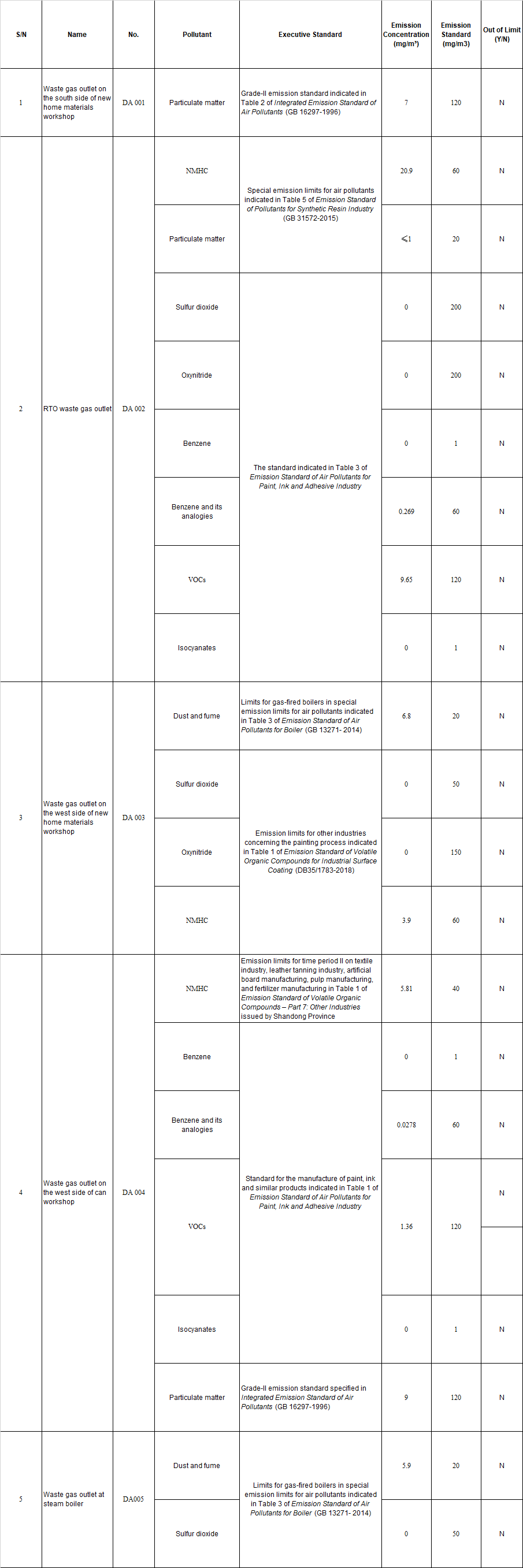
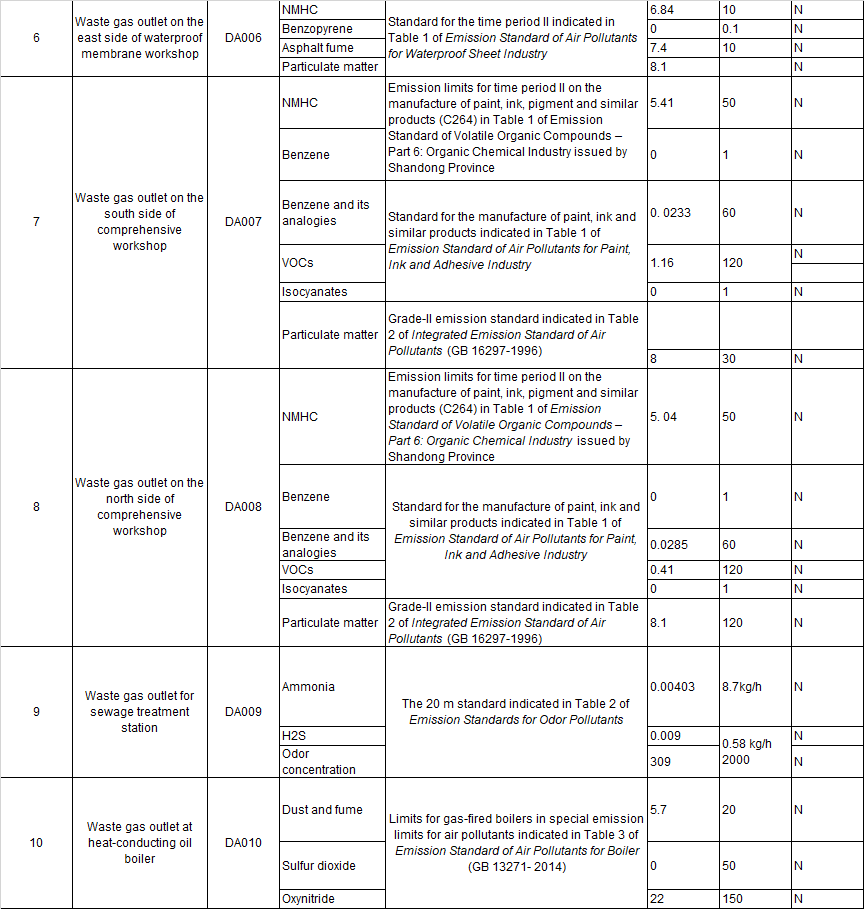
Note: Source of inspection data: the inspection report of Anhui Shangdepu Detection Technology Co., Ltd. dated December 29, 2020 (No.: AHSDP-WT-202012006).
(2) The sewage is discharged into the municipal sewage treatment pipe network of the park after being treated by 3TREES's sewage treatment station, and finally discharged into Shiba River after being treated by the Sewage Treatment Plant on the east of this city.
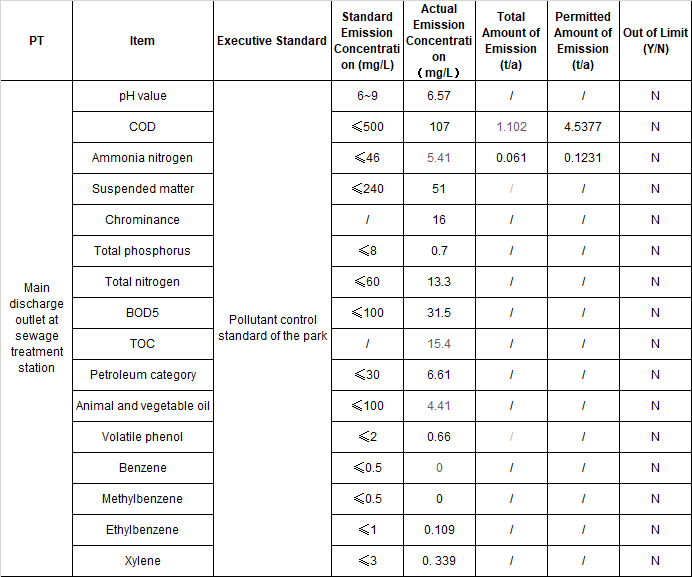
Note: Source of inspection data: the inspection report of Anhui Shangdepu Detection Technology Co., Ltd. dated December 29, 2020 (No.: AHSDP-WT-202012006).
IV. Environmental Impact Assessment (EIA) and Other Environmental Protection Administrative Licensing of Construction Project
V. Energy Consumption
In 2020, the total value of output of 3TREES's factories in Anhui reached 1,018.91 million. The energy consumption details are as follows:
1. Statistics of electricity consumption:
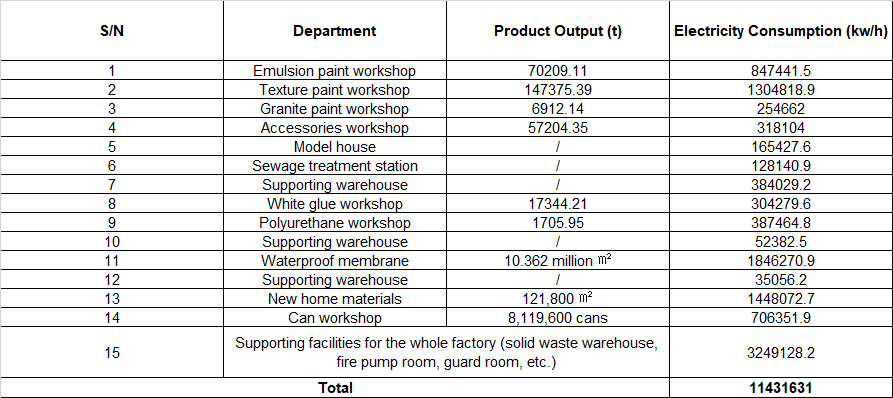
2. The energy consumption per unit of output value is as follows:

VI. Toxic and Harmful Substances
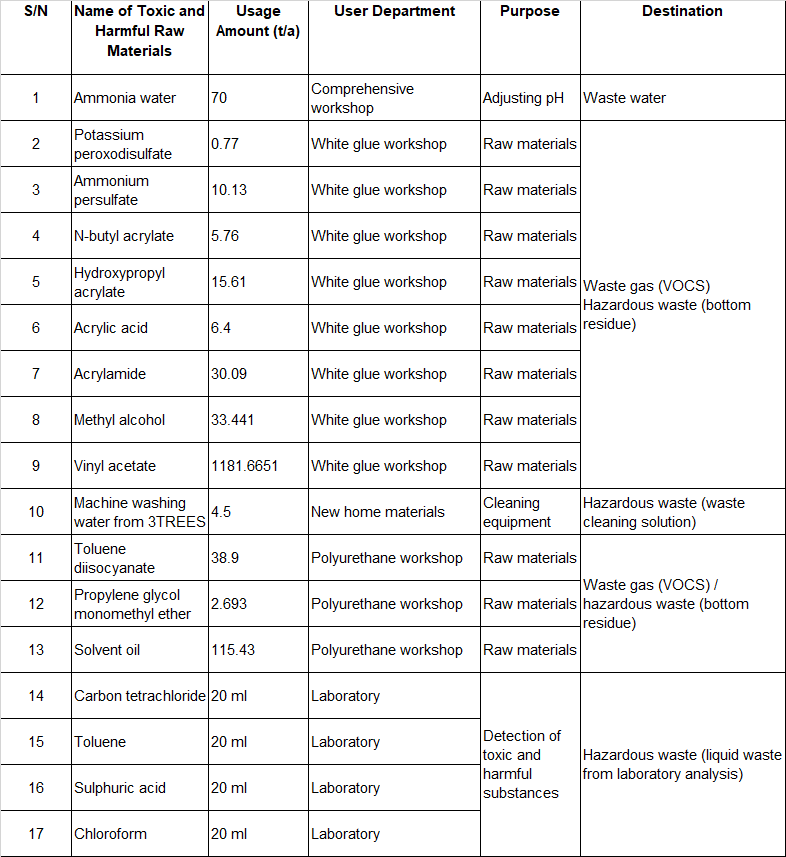
VII. Hazardous Waste Management
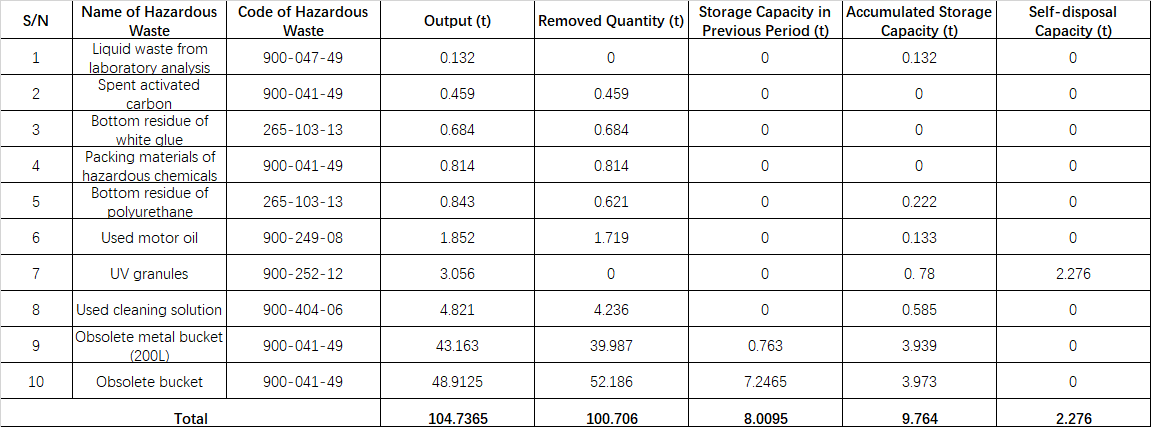
VIII. Environmental Risk Prevention and Control Measures
Generally, work safety accidents are the main cause of sudden environmental accidents. If ineffectively controlled, they will expand and even trigger sudden environmental accidents characterized by the risks of secondary disaster. The prevention of work safety accidents is therefore the only way to prevent sudden environmental accidents. Combined with the requirements on work safety and environmental management, 3TREES has comprehensively monitored the safety and environmental risk sources and proposed corresponding risk prevention measures, to ensure that all safety and environmental risk sources are controllable, reduce the incidence of risk events, and mitigate the harm from such events.
1. Supervision of Environmental Risk Sources
During production, 3TREES's management, accompanied by the safety and environmental protection officers, regularly inspect the factory area. The inspection items include whether the production equipment, gas pipelines, fire protection facilities, environmental protection facilities, and emergency facilities are in sound state, whether there are complete equipment operating ledgers, and whether there are spills and leaks in the storage, loading and unloading areas of materials and finished products and in the temporary storage room of hazardous wastes. The problems found during the inspection are fully recorded and corrected in time. All inspection results are recorded and traceable.
2. Prevention Measures of Environmental Hazards
The Management System for Use of Dangerous Chemicals has been formulated, which incorporates the storage and safe use of dangerous chemicals into daily environmental safety management, and requires to perform environmental safety inspection regularly or irregularly, timely eliminate hazards once found, and not to run equipment involving dangerous chemicals in malfunction conditions. Moreover, following the relevant laws, regulations and standards for hazardous chemicals, 3TREES has prepared the safety management system for hazardous chemicals and hazardous wastes, formulated the safe operation standard, trained employees to master standardized operation, and posted on the wall of each workshop the signboards that contain the chemical characteristics of hazardous chemicals and emergency treatment measures.
(1) Before loading and unloading chemicals, make preparations in advance, learn the properties of chemicals, check whether the tools for loading and unloading are firm, and replace or repair the weak ones. If tools have been contaminated by flammable substances, organic substances, acids, alkalis, etc., they must be cleaned before use.
(2) Operators shall wear corresponding protective equipment depending on the dangerous characteristics of different substances. Protective equipment includes work clothes, rubber aprons, rubber sleeves, rubber gloves, long rubber boots, gas masks, protective oral-nasal masks, gauze masks, gauze gloves, goggles, etc. Before operation, the designated staff shall check whether the protective equipment is in sound state and correctly worn. After operation, the said equipment shall be cleaned or disinfected and kept in a designated cabinet.
(3) When chemicals are scattered on the ground or the truck board, they shall be promptly cleaned to avoid being discharged into rainwater pipe network.
(4) Do not drink or smoke when handling chemicals. Clean hands or face, or gargle or shower in time depending on the working conditions and the properties of hazardous chemicals after work. Always keep air circulation at the operation site. In case of poisoning phenomena such as nausea and dizziness, take a rest in fresh air immediately, take off work clothes and protective equipment, and wash contaminated skin. Send the severe victims to hospital for treatment if any.
(5) In one of the following circumstances, install online monitoring equipment at the waste gas outlets to monitor the discharge of pollutants all the time: 3TREES's waste gas treatment device may run abnormally and the waste gas may exceed the stipulated limits; the emission concentration of waste gas pollutants exceeds a certain threshold; the routine monitoring data of waste gas is abnormal.
(6) In one of the following circumstances, install online monitoring equipment at the wastewater outlets to monitor the discharge of pollutants all the time, and store the wastewater exceeding the emission limits in emergency treatment tanks: 3TREES's wastewater treatment device may run abnormally and the wastewater may exceed the stipulated limits; the emission concentration of wastewater pollutants exceeds a certain threshold; the routine monitoring data and online monitoring data of wastewater are abnormal.


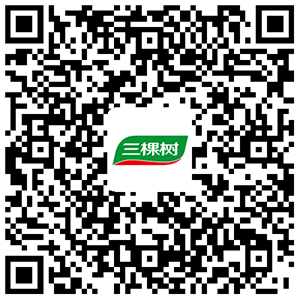



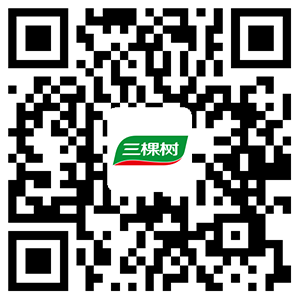


 Tel:
Tel: Email:
Email: Address:
Address:





